Cooler Master MasterWatt Maker 1200 PSU Review
Cooler Master finally released its MasterWatt Maker PSU, which was designed for true enthusiasts. Sporting Titanium-class efficiency, a digital interface, and other exotic features, we didn't expect an affordable price. But $450 looks insane!
Why you can trust Tom's Hardware
A Look Inside And Component Analysis
Parts Description
Before proceeding with this page, we strongly encourage you to a look at our PSUs 101 article, which provides valuable information about PSUs and their operation, allowing you to better understand the components we're about to discuss. Our main tools for disassembling PSUs are a Thermaltronics soldering and rework station, and a Hakko FR-300 desoldering gun.
| Primary Side | |
|---|---|
| Transient Filter | 4x Y caps, 4x X caps, 2x CM chokes, 1x MOV, 2x Infineon CM02X |
| Inrush Protection | 2x NTC Thermistor & 2x Relay |
| Bridge Rectifier(s) | 2x LL15XB60 (600V, 15A @ 124 °C) |
| APFC MOSFETs | 4x Infineon IPP50R140CP (550V, 15A @ 100 °C, 0.14Ω) |
| APFC Boost Diode | 2x Boost Diodes |
| Hold-up Cap(s) | 4x Panasonic (420V, 270uF each, 1080uF combined, 2000h @ 105 °C, TS-HC) |
| Main Switchers | 4x Infineon IPP50R140CP (550V, 15A @ 100 °C, 0.14Ω) |
| FET Drivers | 2x Silicon Labs Si8230BD |
| APFC Controllers | Champion CM6502TX, CM03X Green PFC |
| Switching Controller | Champion CM6901 |
| MCU | STMicroelectronics STM32F302 (72 MHz, 12-bit DACs, USB interface) |
| Topology | Primary side: Full-Bridge & LLC Resonant Converter Secondary side: Synchronous Rectification & DC-DC converters |
| Secondary Side | |
| +12V MOSFETs | Unknown number of FETs |
| 5V & 3.3V | DC-DC Converters: 4x Infineon BSC050NE2LS (25V, 37A @ 100 °C, 5 mΩ) 4x Infineon BSC018NE2LS (25V, 97A @ 100 °C, 1.8 mΩ) PWM Controller: 2x Anpec APW7073 |
| Filtering Capacitors | Electrolytics: Unicon (TW), Nippon Chemi-Con (105 °C, KY, KZE), Rubycon (105 °C, ZL, PX, ZLH, YXG) Polymers: Nichicon, Nippon Chemi-Con |
| Supervisor IC | SITI PS223 (OVP, UVP, OCP, SCP, OTP ) & STMicroelectronics LM339 |
| Fan Model | Cooler Master FA13525L 12LPA (135mm, 12V, 0.50A, 2940 RPM, Loop Dynamic Bearing) |
| 5VSB Circuit | |
| Rectifier | 1x PFR40V60CT (2x 20A, 60V) |
| Standby PWM Controller | Sanken STR-A6062H (26.5W max) |
| -12V Circuit | |
| Voltage Regulator | 1x STMicroelectronics L7912CV (TO-220, -12V, 1.5A) |
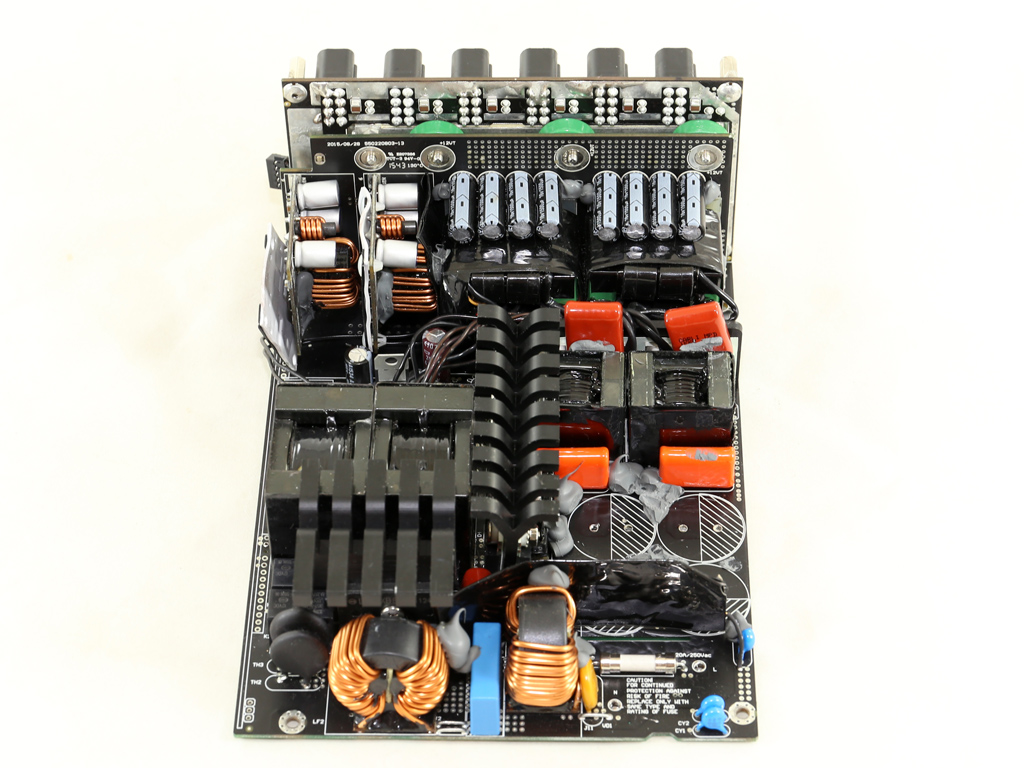



Although it costs more than the AX1500i, which uses a fully digital platform, the MasterWatt 1200 only employs an MCU as a communication link and for monitoring purposes. The most important functions, APFC and switching control, are handled by common analog controllers and not by digital circuits. This is a big let-down for us. Given the huge price tag and the applications that Cooler Master developed exclusively for this PSU, we expected it to be digitally controlled. The design is unique though, and the platform is new. An enhanced APFC converter is used along with a full-bridge topology on the primary side, which is backed up by an LLC resonant converter. On the secondary side, two DC-DC converters generate the minor rails. The FETs that regulate the +12V rail are installed on a board that's close to the main transformers and modular PCB, thereby reducing energy losses on power transfer cables and/or PCB traces.
As we expect from Enhance Electronics, this PSU's build quality is high. And despite a Titanium efficiency rating, the primary side's heat sinks are quite large. The main PCB is fully loaded with components, something that inevitably affects airflow. However the electrolytic caps on the secondary side, along with the bulk caps (the components most sensitive to heat), are in the clear, so their cooling isn't affected. In order to be able to identify most components, we had to do some serious desoldering work. For starters we removed all bulk caps. Afterwards, we dealt with the large vertical board that holds the 5VSB circuit, the MCU, and other interesting components.



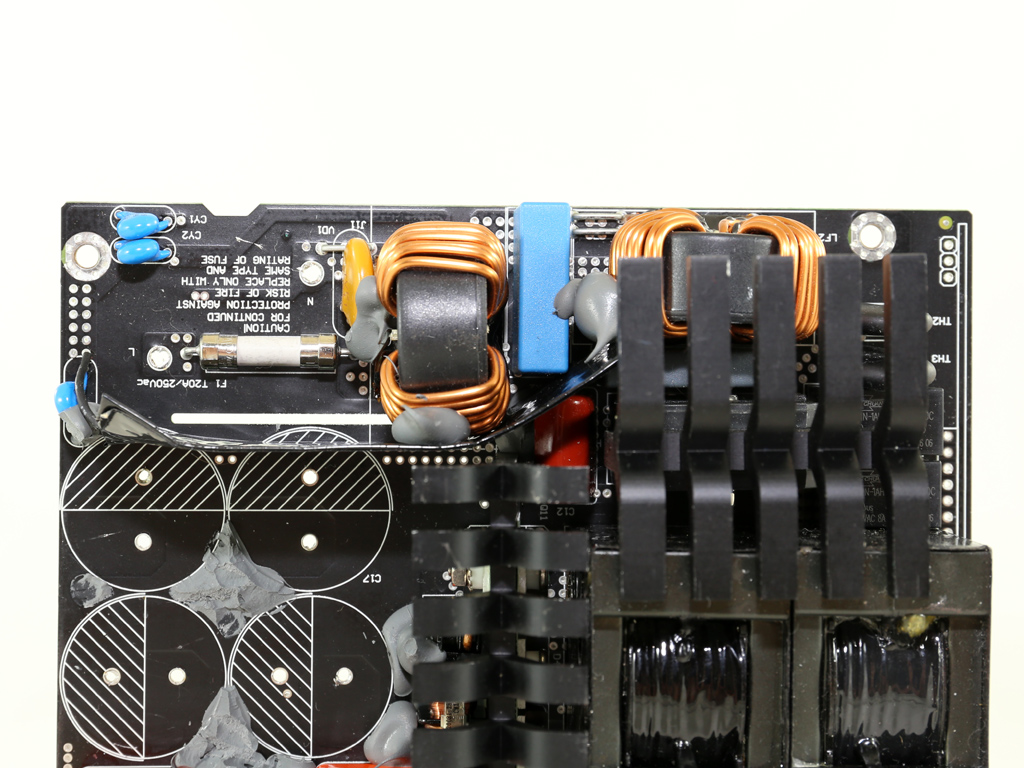




The first part of the transient filter starts at the AC receptacle with three X and a pair of Y caps. It continues on the main PCB with two more Y caps, an additional X cap, two CM chokes and an MOV (Metal Oxide Varistor). In addition, we spot two CM02X ICs on the PCB's solder side, which block current through a X cap's discharge (bleeding) resistor once AC is connected.
Two NTC thermistors are used for lowering inrush current during the PSU's start-up phase. Moreover, each thermistor has its own bypass relay.


A large heat sink with long fins holds a pair of bridge rectifiers (LL15XB60). Combined, they can handle up to 30A of current, easily meeting the demands of a 1.2 kW PSU.





A couple of transformers, along with four Infineon IPP50R140CP FETs and the pair of boost diodes, normally indicate an interleaved PFC design, where two APFC converters work in parallel with a phase difference between them. An interleaved PFC minimizes ripple and lowers conduction losses, increasing efficiency and doubling the effective switching frequency. Unfortunately, the MasterWatt 1200 doesn't use an interleaved PFC because the PFC controller, a CM6502, simply doesn't support it. Instead, Cooler Master would have had to use the Champion CM6565 or Texas Instruments UCC28070. The bulk caps are sourced from Panasonic, their combined capacity is 1080uF, they're rated at 105 °C, and their expected lifetime is 2000 hours at that temperature.
Get Tom's Hardware's best news and in-depth reviews, straight to your inbox.
The PFC controller, a Champion CM6502TX, is installed on the large vertical board that fully covers the APFC side. It is backed up by an Infineon CM03X Green PFC controller.

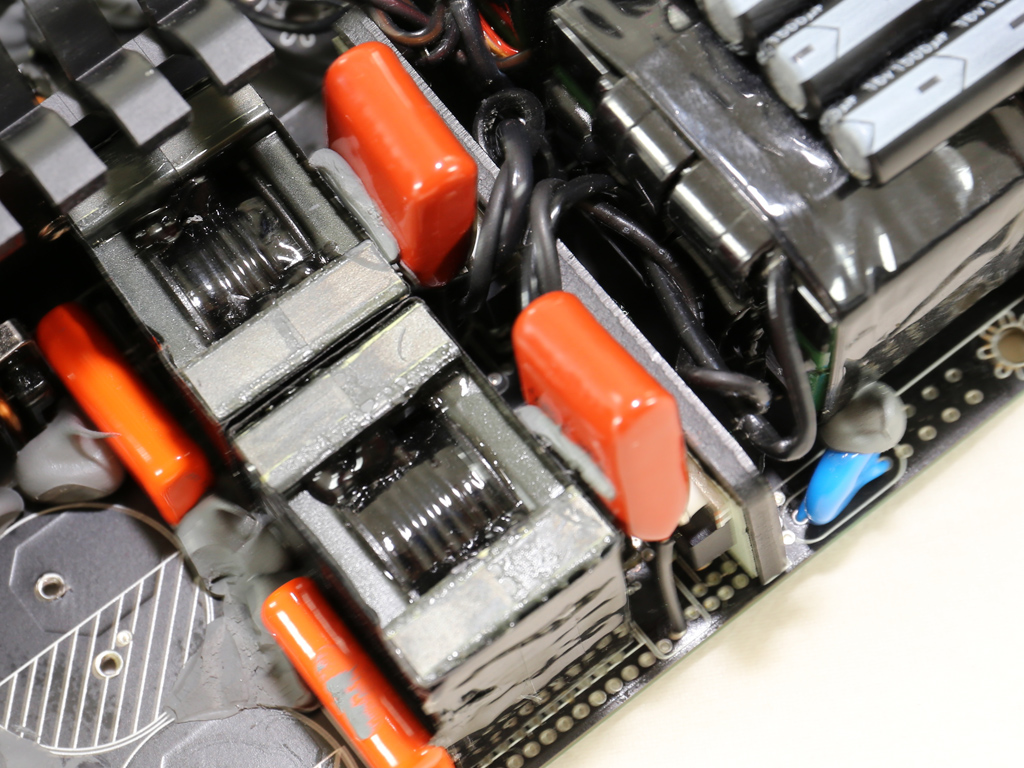


The main switching FETs are four Infineon IPP50R140CPs bolted onto a small heat sink. They are arranged into a full-bridge topology, and are supported by a Champion CM6901 LLC resonant converter that reduces switching losses and increases efficiency.
A couple of Si8230BD ICs installed on the PCB's solder side drive the primary switching FETs.
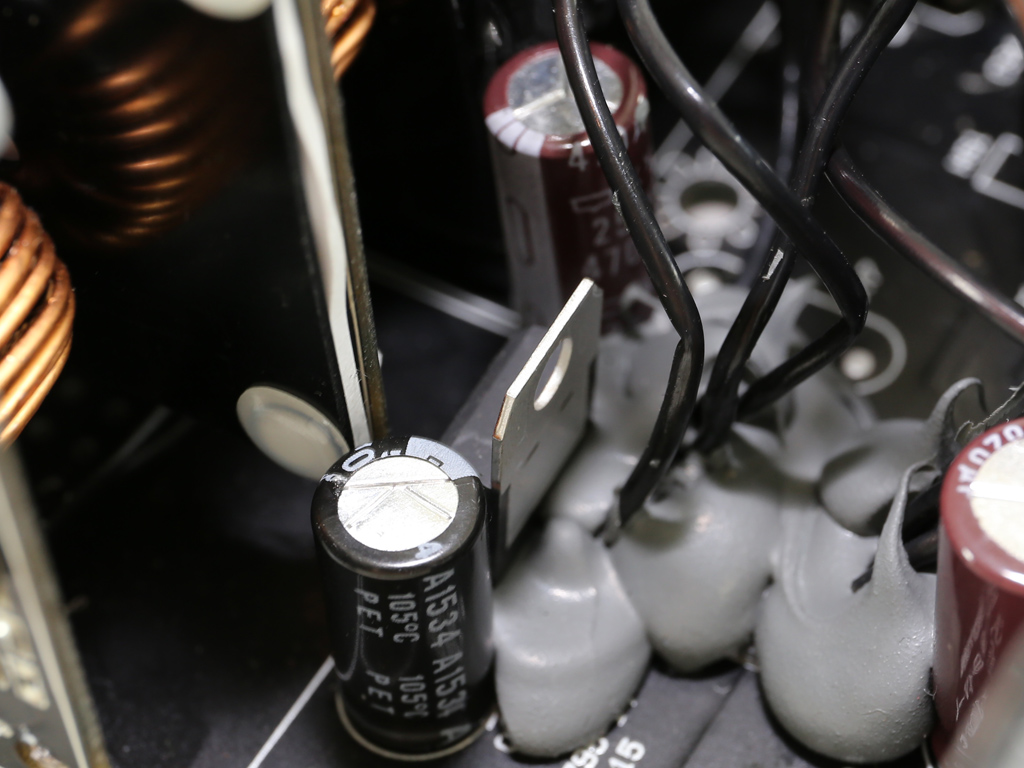

The -12V rail is generated by a STMicroelectronics L7912CV regulator, which can handle up to 1.5A.




A couple of DC-DC converters generate the minor rails. Each converter uses two Infineon BSC050NE2LS, along with two BSC018NE2LS FETs. Two Anpec APW7073 PWM controllers are also used, while the polymer filtering caps are provided by Nichicon.


A large PCB right behind the modular board hosts all FETs that regulate the +12V rail. The main transformers are very close to the +12V FETs, as is the modular board. This leads to reduced energy losses since current passes through shorter distances with decreased resistance. A number of ferrite rings are installed between the modular and +12V board in an effort to suppress EMI noise.
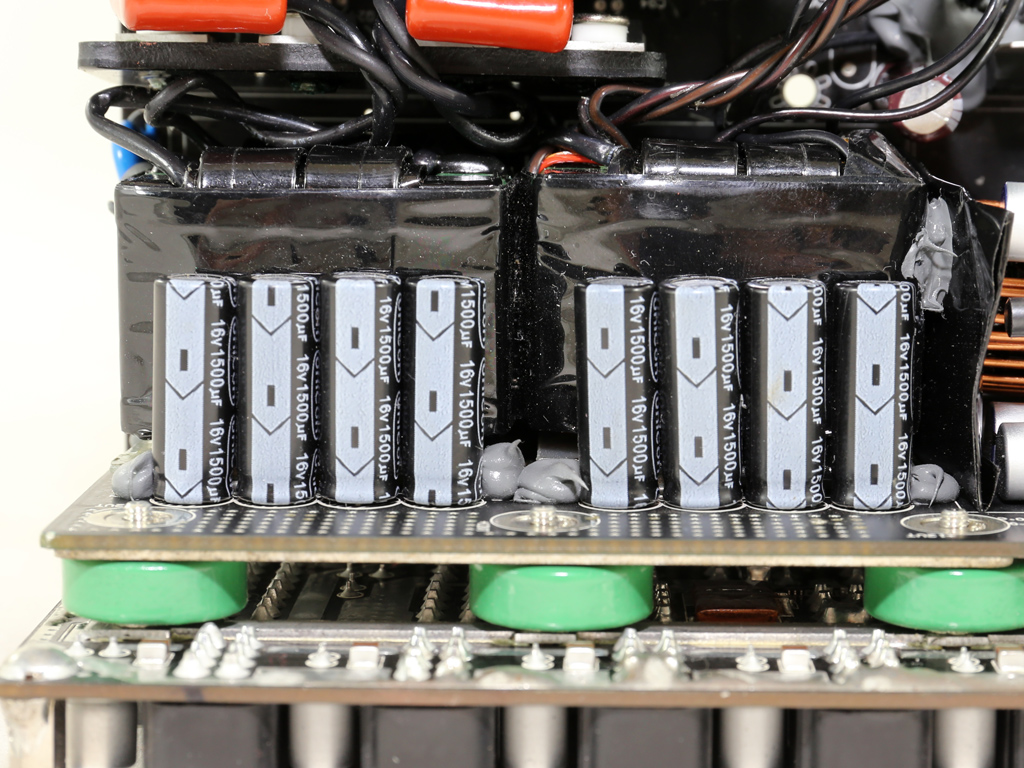


The electrolytic filtering caps that handle the +12V rail are sourced by Unicon, a Taiwanese company. This manufacturer makes good caps, though we'd prefer to see only Japanese caps on such an expensive PSU. The good thing is that the +12V caps are effectively cooled by the unit's fan thanks to their horizontal installation. This PSU's other electrolytic filtering caps are provided by Chemi-Con and Rubycon; they're all rated at 105 °C.



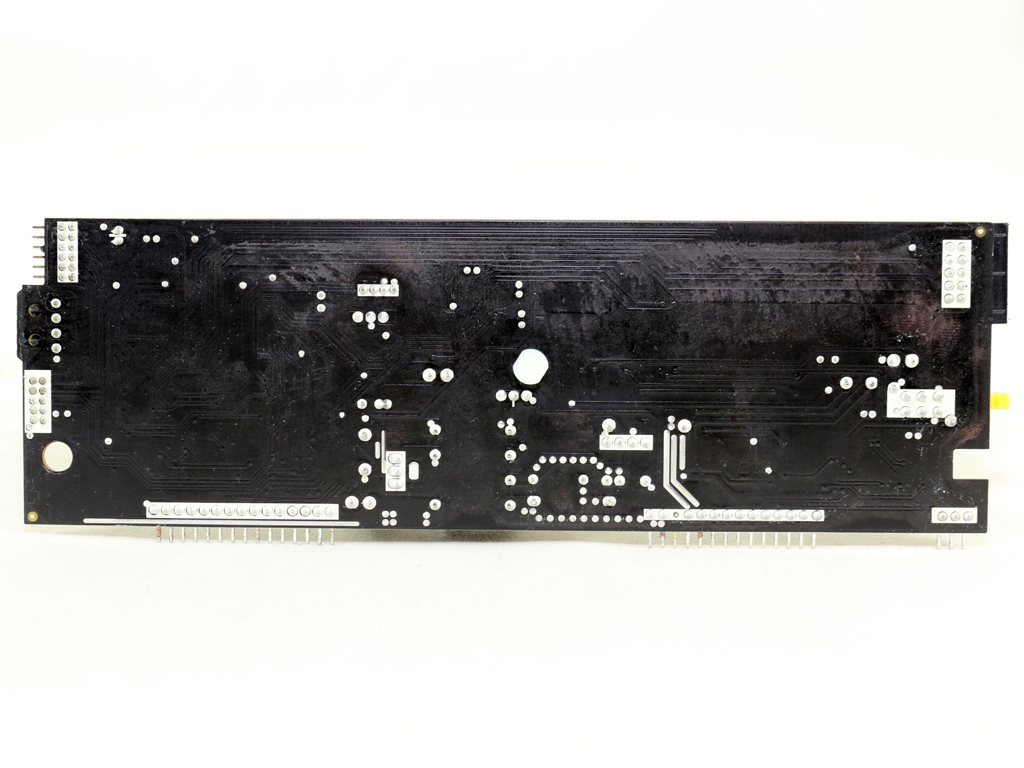
As mentioned, we had to remove the large vertical PCB on the primary side in order to identify crucial components.
A spring-loaded push switch is used to turn power on and off. In our opinion, this is a bad design choice since the switch is less reliable than normal rocker switches. As it happens, our sample's switch broke during our tear-down process, even though we were extra careful with it.
A large number of optocouplers is installed on the main control board.
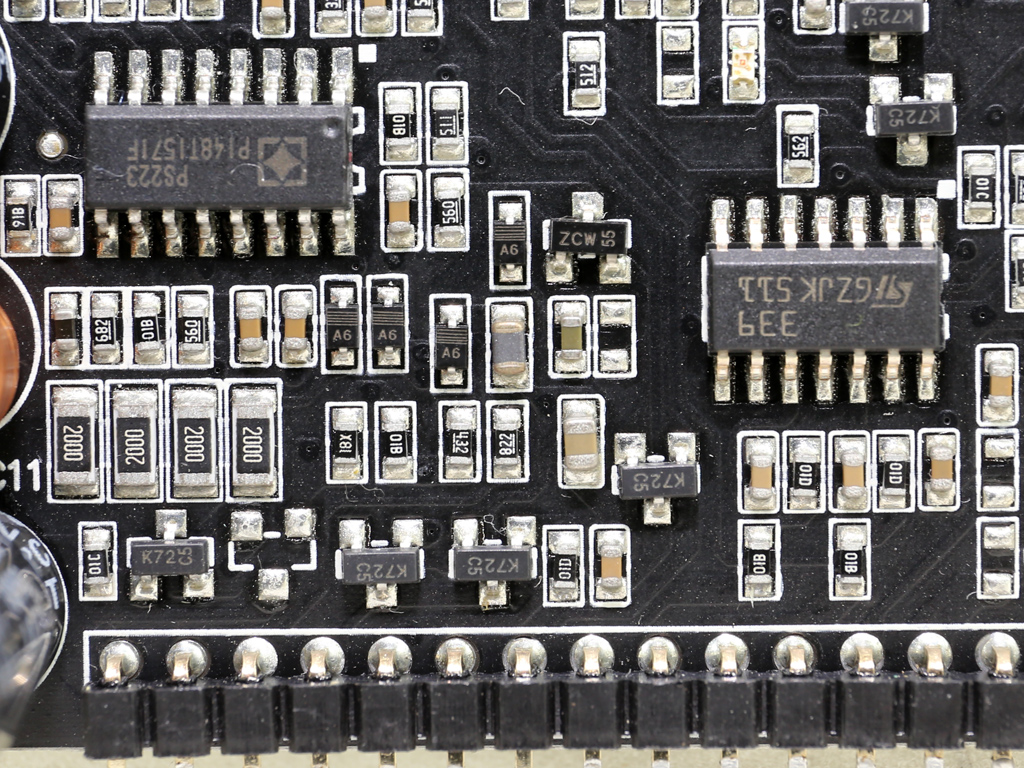

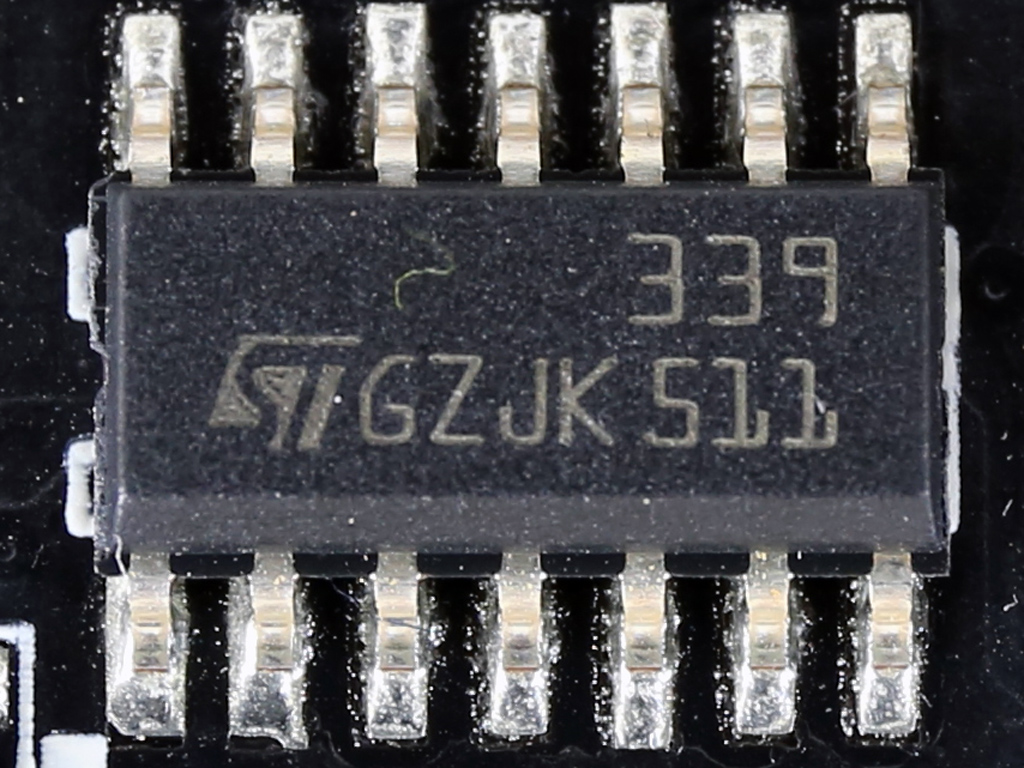
The supervisor IC is a SITI PS223, which supports OTP out of the box. It is backed by an LM339 quad-voltage comparator.


An STM32F302 is the mixed-signal MCU that the PSU uses to communicate across. It contains an ARM Cortex-M4 core clocked at 72 MHz. The MCU includes fast voltage comparators, a couple of op-amps with programmable gain, a fast 12-bit DAC, 144 MHz motor control timers, and a full-speed USB interface. An SKC-8 clock oscillator is also used.



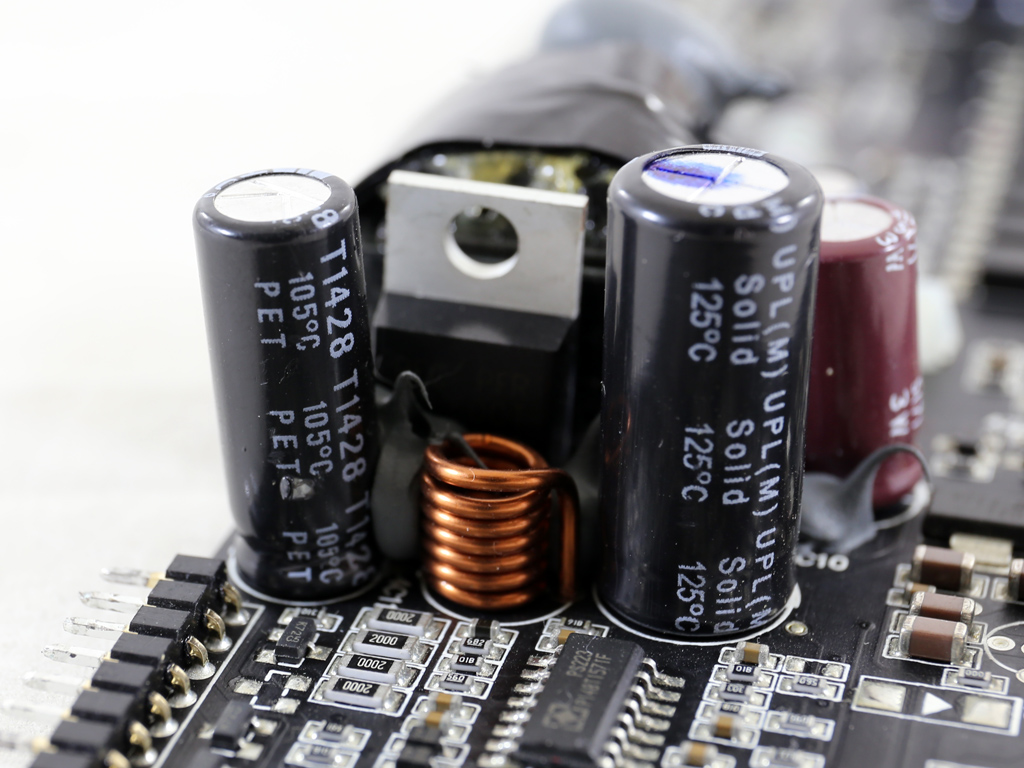

The 5VSB circuit is installed on the control board. The standby PWM controller is a Sanken STR-A6062H IC, while a PFR40V60CT SBR rectifies this output.





A number of Nichicon polymer caps reside on the modular PCB's front side for ripple filtering purposes.




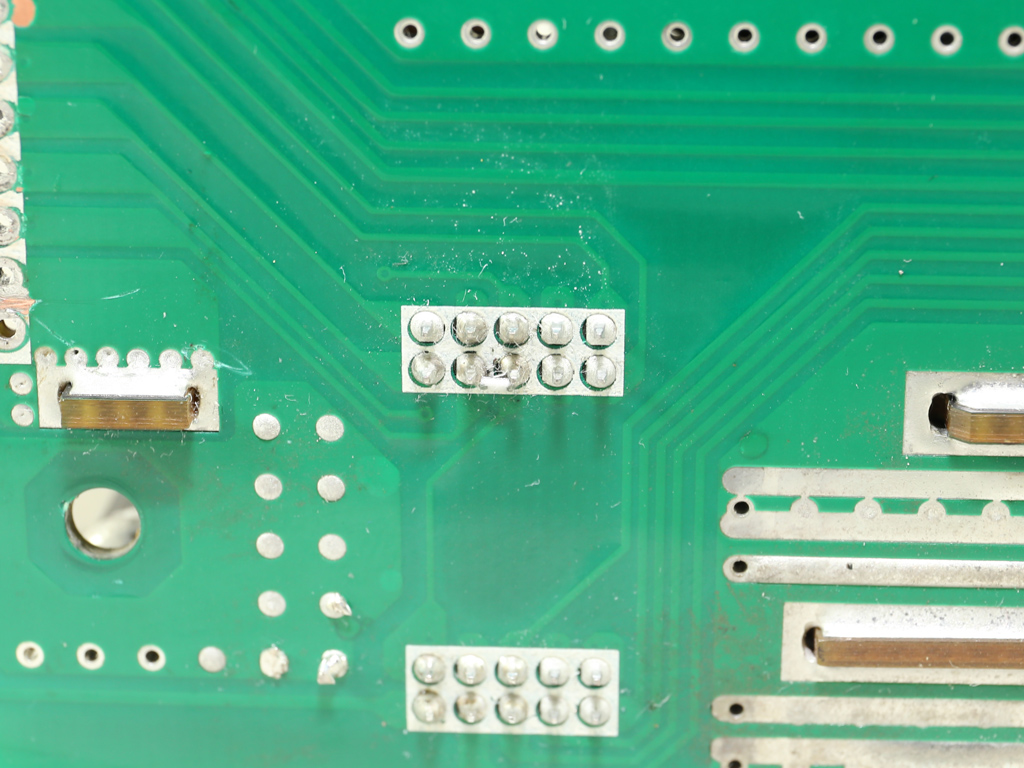

The soldering quality is pretty good, although there are some spots on the PCB with flux residue.


The fan uses a loop dynamic bearing that Cooler Master claims will last at least 160,000 hours. This is a PWM fan and, according to our measurements, its max speed is close to 2940 RPM.
Current page: A Look Inside And Component Analysis
Prev Page Cooler Master Connect Software Next Page Load Regulation, Hold-Up Time And Inrush Current And Protections
Aris Mpitziopoulos is a contributing editor at Tom's Hardware, covering PSUs.
-
Onus Shades of the GX line; Coolermaster swings for the fences, but a competitor (pick one) in the outfield snags it and throws this one out trying to stretch a single to second base.Reply -
MasterMace CM doesn't get to put a $450 price tag on something that isn't in the same park. That voltage regulation is disappointing.Reply -
turkey3_scratch A lot of hype and little delivery for that price tag of course. Lower that price down to $200 and then we may be talking. The efficiency under low loads was quite poor. I'd like to bash the 5VSB regulation, though that's going to be unimportant and unrealistic with the majority of consumers, having load changes on that rail. Though if you are charging multiple devices I'd rather have it at 5V than 4.75V.Reply
At least the transient response performance was really good. The PWR_OK signal, eh. Aris, do you think that transient filter is really enough? I have a feeling it would fail EMI testing, only 4 y caps, 4 x caps, and 2 cm chokes on the unit.
Overall, Cooler Master paired with the wrong OEM. -
Aris_Mp the transient filtering stage looks complete since it has more than the required X caps, however you can never know unless you actually test it. I have the equipment and knowledge but I lack the time to do it :)Reply -
turkey3_scratch What are the exact requirements? I know what the ATX spec says but you have units like the FSP Hydro G 750 that failed by a good margin with 4 y caps, 2 x caps, and 2 cm chokes. So when talking about a 1200W unit with 4 y caps, 4 x caps, and 2 cm chokes, those 2 extra x caps are enough to do the trick?Reply -
Nuckles_56 The performance per dollar chart was great, it showed how badly overpriced this unit is and that there is a lot which could be improved on for the money spent on the unitReply -
Andi lim It's seem like the solid polymer caps on front side modular PCB's not from Nichicon, I think it belongs to Unicon taiwan ( UPT series ).Reply -
jimmysmitty Reply18352433 said:CM doesn't get to put a $450 price tag on something that isn't in the same park. That voltage regulation is disappointing.
Sadly it is more than the AX1500i, lower efficiency and specs overall and a lower warranty (7 year vs 10 year).
If someone is going to spend that much on a PSU It would be better to go for the Corsair.




